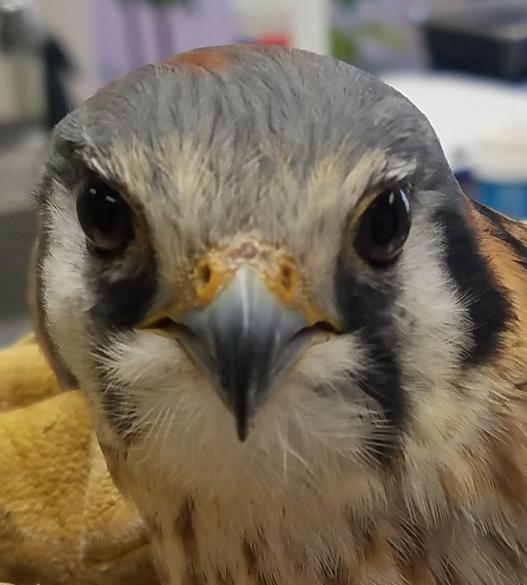October 2023 Edition | Volume 77, Issue 10
Published since 1946
Identifying Causes of American Kestrel Declines to Inform Conservation Actions
Dr. Abby Lawson, Assistant Unit Leader, at the New Mexico Cooperative Fish and Wildlife Research Unit at New Mexico State University, is working with Dr. Kristin Davis, a postdoctoral research associate to identify environmental and demographic drivers of American kestrel population decline to help inform conservation actions. This project is a collaboration and includes the U.S. Fish and Wildlife Service (USFWS) National Raptor Program, USFWS Migratory Bird Management Southwest Region, USFWS Migratory Birds, USGS Southeastern Climate Adaptation Science Center, and the Cornell Lab of Ornithology.

American kestrels (hereafter referred to as kestrels) are declining across most of their North American range at a steady rate of approximately -1.4% per year (Sauer et al. 2019). The causes of kestrel decline remain unknown.
Given the steady and widespread downward trend in kestrel numbers, a failure to identify and address the factors driving the decline will predictably lead to a need to list the species as threatened or endangered under the Endangered Species Act (ESA).
Until the cause or causes of the kestrel decline are identified, effective corrective management actions cannot be initiated. Kestrels are identified as a species of concern in 21 State Wildlife Action Plans (McClure et al. 2017), and they are included in several regional lists of Birds of Conservation Concern by the U.S. Fish and Wildlife Service (USFWS 2021).
This study draws on existing data to explain the drivers of kestrel declines at continental and regional (flyway) scales. The overall goal of the study is to identify drivers of kestrel declines and evaluate the expected value of region-specific management alternatives. Specific objectives related to this goal include:
- develop a continental-scale integrated population model using long-term, large-scale count data and banding data to quantify the relative influence of survival and fertility on population trends,
- generate hypotheses to identify causes of kestrel population decline and prioritize future monitoring and research activities through value of information, and
- use results from the large-scale population model and expert-elicited hypotheses to develop regional-scale models to evaluate how specific drivers of decline vary across the kestrel range.
Kestrels are associated with open country and grasslands, and grassland birds are among the most rapidly declining avian groups in North America (Rosenberg et al 2019). Although loss of habitat is one hypothesized factor in the decline of grassland birds, the cause of the kestrel decline remains unknown despite several local studies and two broad reviews of available data (Farmer et al. 2006, Smallwood et al. 2009, McClure et al. 2017).
Recently, a comparative analysis of data from several kestrel populations showed that immigration rates and adult survival likely drive changes in kestrel populations. However, this study was not able to explain the role of these factors, or other intrinsic or extrinsic drivers, in the ongoing decline (McClure et al. 2021).
Unlike previous efforts to identify causes of decline, the researchers with the USFWS National Raptor Program have developed an integrated population model at the continental scale, thereby narrowing the potential large-scale drivers to age and sex-specific survival and fecundity. Furthermore, Abby, Kristin and their team are integrating large-scale, long-term count data and banding data that will improve our ability to make inference at a continental scale.
In January 2023, the research team hosted a rapid prototyping workshop with species experts, land managers, and USFWS decision makers. At the workshop, the continental-scale results were presented and used as the basis for developing regional-scale hypotheses that can be tested through management actions and existing monitoring programs. The hypotheses developed from the workshop, in turn, will be used to identify important drivers of decline that will be incorporated into regional-scale population models.
The study takes place at multiple spatial scales, beginning with a continental-scale analysis of kestrel vital rates and population trends. From there, Abby and her team are focusing on explaining the regional drivers of population trends and evaluating the efficacy of proposed management alternatives within each flyway. This study relies on existing structured survey data (banding data from the Bird Banding Lab, fecundity data from a meta-analysis of existing studies) and community-science data (Breeding Bird Survey).
The CRU Program enhances graduate education in fisheries and wildlife sciences and enables research between natural resource agencies and universities on topics of mutual concern.Dr. Kristin Davis is a postdoctoral research associate working in Abby’s Lab within the Department of Fish, Wildlife, and Conservation Ecology at New Mexico State University through the New Mexico CRU. As part of her role with the project, Dr. Davis is receiving hands-on training in structured decision making (SDM), conducing decision-support modeling, facilitation, and working with stakeholder groups.
The ONB features articles from Cooperative Fish and Wildlife Research Units across the country. Working with key cooperators, including WMI, Units are leading exciting, new fish and wildlife research projects that we believe our readers will appreciate reading about. This article was written by Abby Lawson, ajlawson@nmsu.edu, Assistant Unit Leader, New Mexico CRU, and edited by Dawn Childs, dchilds@usgs.gov, Information Specialist, USGS. Read the Audubon story.